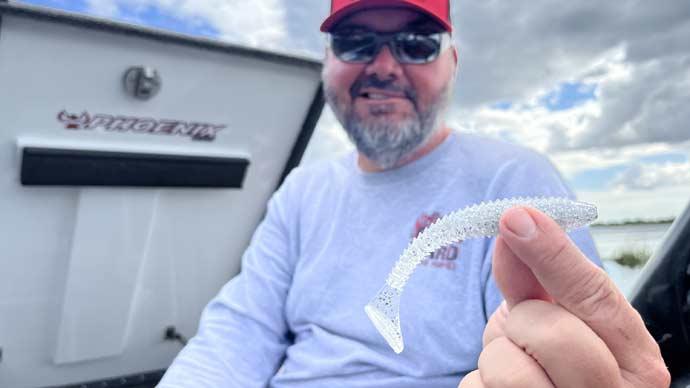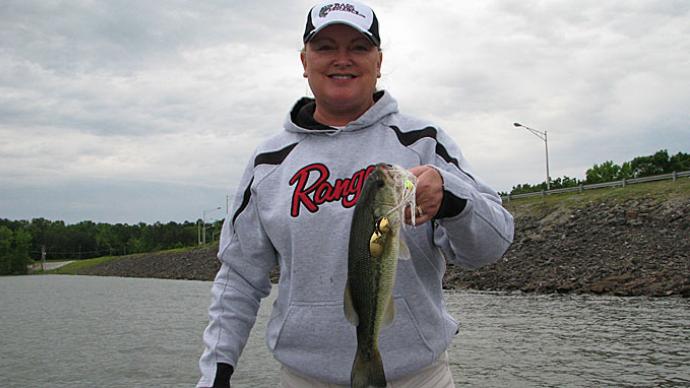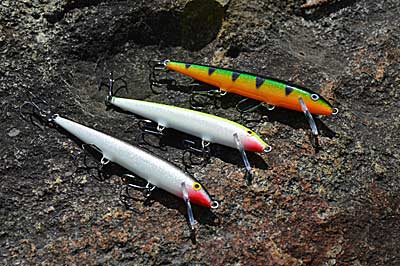
Spring is here. The sun is shining, temperatures are warming, and life is awakening from winter’s funk. Bass and the anglers who chase them are no different. Their thoughts turn to shallow water and enjoying some of the year’s best conditions. And no other time on the calendar is encountered more than during May.
May is a time of transition. Even in the coldest spots within their range, at least some bass will be done spawning by Memorial Day. And everywhere, others are preparing to spawn and more recuperating from those annual rigors. But finding bass is half the battle. Winning it requires selecting the best lures and techniques for the situation. And during May, you need ones that catch bass in any spawn stage.
Despite the variety of scenarios that you'll find bass during May, you don't need a shop's worth of tackle to catch them. Instead, tie on these five baits — and a bonus — and you’ll be ready, no matter what the bass are doing on your favorite waters.
-
Floating Jerkbait
- Examples: Bagley Bang O Lure, Rapala Original Floater, Smithwick Floating Rattlin’ Rogue
- Size: 4 inches to 5 inches
- Phases: Prespawn, spawn and post-spawn
Whenever they need a jerkbait, most bass anglers reach for a suspending model. But those are so April. Instead, you want a floating model in May when warming water pushes bass shallow and makes them aggressive. It stays near the surface and away from potential snags, and its buoyancy adds action. Not only does it twitch, slash, and dive, but it quickly ascends.
Whether slowly twitching your floating jerkbait across the surface for spawners or quickly working it past shallow cover for prespawners or post-spawners, you’ll need to find the best combination of jerks and pauses. But, of course, that cadence changes daily with conditions and location. So, experiment until you get bites.
Creating the cadence that draws the most action comes from choosing the proper rod and line. Here’s what you need:
- Rod: A 7-foot casting rod is just right — long enough to increase casting distance and short enough to make the downward sweeps that bring your jerkbait to life. Its medium power will control unruly bass, and its moderate action will keep trebles hooked.
- Reel: A high-speed — 7:1 or greater gear ratio — casting reel will quickly collect line during pauses in your retrieve, ensuring you’re always prepared for hooksets.
- Line: 8- to 12-pound test monofilament line is nearly invisible in clear water, and it floats, keeping your jerkbait near or on the surface.
Getting your floating jerkbait to dive a bit deeper, maybe to reach the tops of submerged aquatic vegetation, can be done a couple of ways. You can add some dots or strips of lead tape on either side of the front treble hook. A more straightforward option is reducing or eliminating the pauses in your retrieve. Continuous twitching keeps it diving and not rising toward the surface.
-
Bladed Jig
- Examples: Berkley Slobberknocker, Strike King Thunder Cricket, Z-Man Chatterbait JackHammer
- Size: 4 inches to 5 inches, including soft-plastic trailer; 3/8 to ½ ounce
- Phases: Prespawn and post-spawn
Bass are especially cover oriented but not always grouped in May. They pause on the submerged brush and aquatic vegetation during prespawn movements, for example, and cling to isolated pieces of wood and docks as they move toward deep water during post-spawn. So, you need a lure that goes after them and covers water. That lure is the bladed jig.
While the typical bladed jig lacks a weed guard, the angle and size of its blade wards off snags, whether you’re fishing through the flooded brush, in aquatic vegetation, or under docks. A simple steady retrieve creates a violent shaking action that appeals to aggressive bass and elicits reaction strikes from those stunned by all too frequent cold fronts.
Shallow or deep, clear or dirty water, the best presentations for bladed jigs start with an accurate cast and finish with wrestling big bass from heavy cover. Here’s what you’ll need to make that happen:
- Rod: A 7-foot casting rod can fan cast a flat and pitch into heavy cover. You’ll want a fast action for casting accuracy and a heavy power to handle big bass.
- Reel: Most bladed jigs work best at a medium retrieve, so select a casting reel with at least a 6.3:1 gear ratio. That’ll keep you from working on it too fast.
- Line: Keep connected to your bladed jig in the heaviest cover by spooling your reel with 50- to 65-pound test braided line.
A vibrating jig isn’t complete without a soft-plastic trailer. Popular styles include minnow shapes, such as Berkley’s PowerBait Power Stinger, or swimming craws, such as Zoom's Ultra-Vibe Speed Craw. Adding one increases action and creates a bulky profile, something big bass love. The latter also helps it run shallower and slower, which trigger strikes from all springtime bass.
-
Image
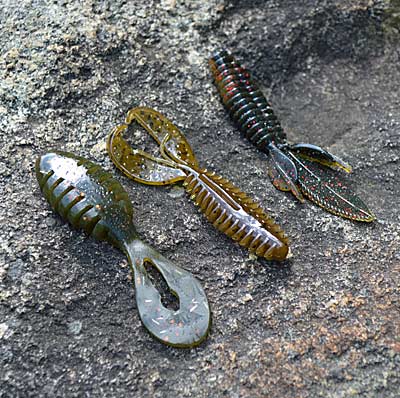
Beaver-style baits consistently catch bass throughout May. Start by fishing them for prespawn bass around submerged cover. Then use one for sight fishing around spawning beds and pitching at post-spawners holding on isolated cover. Photo by Pete M. Anderson Texas-Rigged Beaver-Style Bait
- Examples: Berkley PowerBait Maxscent Creature Hawg, Big Bite Baits Fighting Frog, Reaction Innovations Sweet Beaver
- Size: 3 inches to 4 inches
- Phases: Prespawn, spawn and post-spawn
A beaver-style bait will cover your fishing needs for the entire month, regardless of whether the bass in your favorite fishing hole are staging, spawning, or recuperating. The only adjustments you'll make are weight and color.
For example, rig a green-pumpkin one with a 3/8-ounce weight to probe submerged aquatic vegetation outside spawning flats. Add a 3/16-ounce weight to one that's white or chartreuse, making it easy to see bites while sight-fishing for bedding bass. And a black-and-blue one with a ½-ounce weight makes long pitches to isolated pieces of cover easy, creating the quick fall that triggers reaction strikes from post-spawners.
Placing your beaver-style bait on targets, enticing strikes, and landing bass requires a specific combination of rod, reel, and line. Try these:
- Rod: Select a 7 1/2- to 8-foot casting rod with a heavy power to pull bass from thick cover and fast action for snappy hooksets. Avoid extra-fast actions, whose stiffness makes accurate casts and pitches difficult.
- Reel: A high-speed casting reel — at least a 7:1 gear ratio — quickly picks up the line, whether slack for a solid hookset or a fruitless pitch, so you can make another presentation without delay.
- Line: Spool your reel with 50- to 65-pound test braided line, which is sensitive and strong. If its visibility in clear water bothers you, add a couple of feet of 20- or 25-pound test fluorocarbon leader. But the bass won’t mind; they’re occupied with what dropped next to them.
Pegging bullet weights is popular, especially when fishing heavy cover. But sliding weights get more bites, so save it for the stickiest situations. And when you do, place your stopper slightly up the line, giving your weight about an inch to move. Finally, add a glass bead before tying on your hook. The weight will strike it, making a clicking sound that attracts bass.
-
Medium-Diving Crankbait
- Examples: Bomber Gen 2 Fat-Free Shad Jr., Norman Deep Little N, Rapala DT10
- Size: 2 ½ inches to 3 inches; 3/8 to 5/8 ounce
- Phases: Prespawn and post-spawn
Before and after they spawn, bass are found in slightly deeper water. And while they can form small schools, especially during prespawn, they’re usually spread out. It’s no different during post-spawn. A medium-diving crankbait is one of the best lures for finding and catching them.
Efficiency is a crankbait’s calling card. They’re easy to cast long distances, thanks to their weight and aerodynamic shape, and the typical retrieve is speedy. While square-bill crankbaits are popular in spring, choose one with a rounded bill. Instead of trying to bulldoze through cover, these roll around it, especially wood, leading to fewer snags but just as many strikes.
Choose a crankbait that runs 5 to 10 feet deep, which is plenty to reach the prespawn and postspawn cover that bass prefer in May. This gear will get your crankbait there:
- Rod: The best rods for medium-diving crankbaits have a moderate action, which keeps feisty bass hooked on trebles, has a medium-heavy power, and measures 7 feet, maybe a few inches longer.
- Reel: A casting reel with a gear ratio of about 6.3:1 makes the medium retrieve speeds that help these crankbaits reach their maximum depth almost effortlessly.
- Line: Spool your reel with 10- to 14-pound test fluorocarbon.
While the traditional pairing for crankbaits and other treble-hooked lures is monofilament line — it’s stretchy, helping keep thrashing bass hooked — switch to fluorocarbon here. It’s more durable than monofilament, reducing breakoff worries as your crankbait grinds through cover. And it sinks, squeezing a tad more depth from your crankbait.
-
Soft-Plastic Toad
- Examples: NetBait BaitFuel BF Toad, Stanley Ribbit, Zoom Horny Toad
- Size: 3 ½ inches to 4 inches
- Phases: Post-spawn
Image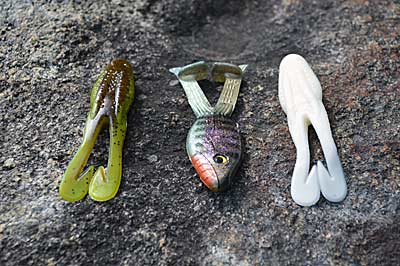
May ushers in topwater fishing. A soft-plastic toad rigged Texas style will catch plenty of post-spawn bass, whether buried in emerging aquatic vegetation, swimming along rip-rap, or hiding under docks. Photo by Pete M. Anderson May, especially as more bass transition to post-spawn, is an exciting time for fishing topwaters. While walking baits, such as Heddon’s Zara Spook, and poppers have their place, you’ll get more action from a soft-plastic toad. They’re at home in aquatic vegetation, around laydowns and docks, and along rip-rap walls.
Fish yours with a steady retrieve, turning it into a finesse version of a buzzbait. Its Texas-style rigging will keep you going regardless of the cover you come across. Based on the toad's length, rig it with a 3/0 or 4/0 round bend hook. More of its gap is exposed, making hookups more likely. And if yours is riding too high in the water, or you need more weight to increase casting accuracy, add a 1/16-ounce bullet weight in front.
Increasing your strike-to-hookup ratio with soft-plastic toads requires the right gear. Throw yours on this:
- Rod: The best measure 7- to 7 ½-feet long, have a fast action for accurate casts and quick hook sets, and a heavy power to wrestle bass from heavy cover.
- Reel: Choose a high-speed reel with a gear ratio of at least 7:1. It’ll make keeping your toad topside easy.
- Line: 50-pound test braided line casts easily and cuts through aquatic vegetation. Its lack of stretch ensures solid hooks, no matter the direction the bass that just ate your toad swims.
A fast-action rod and braided line quicken your reaction time, which is most likely already heightened by the promise of an exciting blowup on your soft-plastic toad. So, it's essential to remain calm when a strike happens. Instead of setting the hook at the first sign of a splash, wait until you feel the weight of the bass. You have time: With a single hook and soft-plastic body, a bass won’t readily release the prize it worked so hard to grab.
Bonus: Big Swimbait or Glide Bait
- Examples: Berkley Cull Shad, Deps Slide Swimmer 175, Megabass Magdraft
- Size: 5 inches to 8 inches
- Phases: Prespawn and post-spawn
May is prime time for these big baits across most of the bass range. In addition, big bass are concentrated on shallow-water cover, making them easier to find and catch.
These large baits have proven successful on even some of that nation’s most-pressured bass waters, including North Carolina’s Lake Norman. Standing in the shadows of growing Charlotte, it’s bombarded by bass anglers seven days a week, 12 months of the year. It hosted the 2023 MLF REDCREST championship when many top finishers slung these large baits around docks.
Those successes create confidence in a size of lure that not long ago would be brushed aside by nearly every bass angler, except maybe for a few in Southern California. And that’s why we’re considering them a bonus. Tie one on, and start slinging it at shallow cover when the situation presents itself. Pick out the pieces nearest deep water, whether the main lake or creek channel. The availability of those escapes attracts the biggest bass.
Casting and retrieving big baits requires specialized gear. Here’s what you’ll need:
- Rod: Your 7 ½- to 8-foot rod should have a heavy power and moderate to fast action.
- Reel: Choose a 300-series casting reel with a 6.3:1 gear ratio. A sauntering retrieve works best.
- Line: Spool your reel with 50-pound test braided line or 25-pound test fluorocarbon line.
Patience is paramount to scoring with big baits. Put in your time, and you’ll be rewarded. That may not happen every trip, but it's always a winner when it happens.


